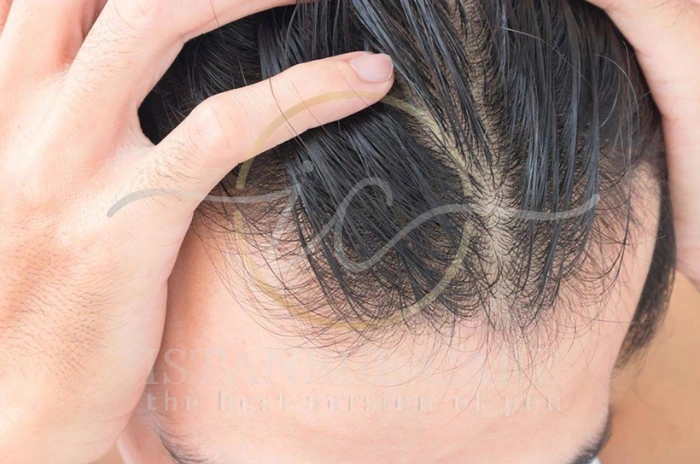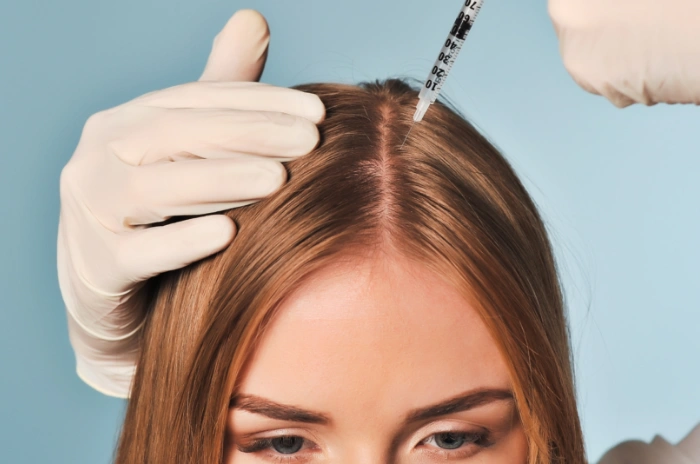Experiencing hair loss and thin hair can be distressing for both men and women. Understanding the underlying causes of hair loss and exploring effective treatment options for thinning hair is crucial for maintaining healthy hair and confidence. This comprehensive guide examines the science behind hair thinning, explores proven treatments like minoxidil and finasteride, and discusses both medical and natural approaches to promote hair growth.
Whether you’re dealing with male pattern baldness, female hair thinning, or stress-related hair shedding, this article provides evidence-based solutions to help you make informed decisions about your hair health journey.

What Causes Thinning Hair?
Understanding the root causes of hair loss is essential for selecting the most effective treatment approach. Multiple factors can contribute to hair thinning, from genetic predisposition to lifestyle choices.
Hormonal Changes and Hair Loss
Hormonal hair loss represents one of the most common causes of thinning hair. Androgenetic alopecia, affecting both men and women, occurs when hair follicles become sensitive to dihydrotestosterone (DHT). This hormone causes follicles to shrink progressively, leading to shorter hair cycles and eventual hair loss.
In women, hormonal fluctuations during menopause, pregnancy, or thyroid disorders can trigger significant hair thinning. The decrease in estrogen levels allows DHT to have a more pronounced effect on hair follicles, resulting in diffuse thinning across the scalp.
Common Medical Conditions Linked to Thinning Hair
Several medical conditions can cause hair loss and contribute to thinning. Autoimmune disorders like alopecia areata attack hair follicles directly, while thyroid imbalances affect the hair growth cycle. Polycystic ovary syndrome (PCOS) increases androgen levels, accelerating hair loss in genetically susceptible individuals.
Scalp conditions such as seborrheic dermatitis or fungal infections can also damage hair follicles and impede healthy growth. Early identification and treatment of these underlying conditions are crucial for preventing permanent hair loss.
How Stress Contributes to Hair Thinning
Stress and hair loss are closely connected through a condition called telogen effluvium. During periods of physical or emotional stress, hair follicles prematurely enter the resting phase, leading to increased shedding 2-3 months later.
Chronic stress elevates cortisol levels, which can disrupt the normal hair growth cycle and reduce the production of important growth factors. This type of stress hair shedding is typically reversible once stress levels are managed effectively.
Nutritional Deficiencies That Affect Hair Health
Iron deficiency hair loss is particularly common in women and can significantly impact hair density and quality. Other nutrient deficiencies, including vitamin D, biotin, zinc, and protein, can also compromise hair health and contribute to thinning.
Poor dietary habits, restrictive eating patterns, or malabsorption issues can lead to nutritional deficiencies that manifest as hair problems. Addressing these deficiencies through proper nutrition or supplementation often improves hair quality and growth.
Early Signs of Thinning Hair
Recognizing the early signs of thinning hair allows for prompt intervention and better treatment outcomes. Understanding these warning signs helps individuals seek appropriate care before significant hair loss occurs.
Scalp Shows Through and Hair Becomes Finer
One of the first noticeable changes is when the scalp becomes more visible through the hair, particularly in areas like the crown or part line. Hair strands also become progressively finer and weaker, lacking their previous thickness and strength.
Changes in hair texture, increased breakage, and slower hair growth are additional early indicators. Many people notice that their ponytail feels thinner or that they need to wrap hair ties around more times than before.
Recognising Follicle Miniaturization Early
Follicle miniaturization is a key process in androgenetic alopecia where hair follicles gradually shrink over successive growth cycles. This results in progressively shorter and finer hairs until follicles eventually stop producing visible hair altogether.
Early detection of miniaturization through professional examination can guide treatment decisions. Dermatoscopy and other diagnostic tools help identify this process before it becomes visually apparent, allowing for earlier intervention.
Effective Treatments for Thinning Hair
Modern medicine offers several proven treatments for thinning hair that can slow progression, maintain existing hair, and in some cases, promote regrowth. The key is selecting appropriate treatments based on the underlying cause and individual circumstances.
Medications for Hair Loss: Minoxidil and Finasteride
Minoxidil for hair loss is FDA-approved for both men and women and works by extending the growth phase of hair follicles and improving blood circulation to the scalp. Available in 2% and 5% concentrations, it requires consistent daily application for optimal results.
Finasteride is an oral medication approved for men that blocks the conversion of testosterone to DHT. This treatment for thinning hair can significantly slow hair loss and promote regrowth in many patients, though results vary individually.
Both medications require long-term use to maintain benefits, and discontinuation typically results in the return of hair loss patterns within 6-12 months.
Natural Remedies to Promote Hair Growth
Essential oils for hair growth, including rosemary, peppermint, and cedarwood, have shown promising results in clinical studies. These oils may improve scalp circulation and provide anti-inflammatory benefits when used consistently as part of a comprehensive hair care routine.
Hair growth remedies like scalp massage, onion juice, and green tea extracts have varying degrees of scientific support. While not as rigorously studied as pharmaceutical options, many individuals find these natural approaches helpful as complementary treatments.
Hair Care Practices to Prevent Further Thinning
Gentle hair handling, avoiding excessive heat styling, and using appropriate hair products can prevent additional damage to already compromised hair. Best shampoo for thinning hair typically contains ingredients like ketoconazole, caffeine, or saw palmetto that may support scalp health.
Reducing chemical treatments, using wide-tooth combs, and avoiding tight hairstyles help minimize mechanical stress on weakened hair follicles. Proper hair care practices are essential for maximizing the effectiveness of other treatments.
When to Consider Hair Transplant Surgery
Hair transplant procedures become viable options when non-surgical treatments fail to provide satisfactory results or when hair loss is extensive. FUE hair transplant and DHI hair transplant techniques offer natural-looking results with minimal scarring.
Ideal candidates typically have stable hair loss patterns, adequate donor hair, and realistic expectations. Combining transplant procedures with medical treatments often provides the best long-term outcomes.
What Treatments Help Thinning Hair?
Beyond pharmaceutical interventions, several complementary treatments can support hair health and potentially improve thinning hair conditions.
Scalp Massage for Better Growth
Regular scalp massage increases blood circulation to hair follicles, potentially extending the growth phase and improving hair quality. Studies suggest that 4 minutes of daily scalp massage for 24 weeks can increase hair thickness.
The mechanical stimulation may also help reduce DHT accumulation around follicles and promote the release of growth factors. This simple, cost-effective intervention can be easily incorporated into daily routines.
Essential Oils With Possible Benefits
Essential oils for hair growth offer natural alternatives or complementary treatments to conventional therapies. Rosemary oil has demonstrated comparable effectiveness to 2% minoxidil in some studies, while peppermint oil may stimulate hair growth through improved circulation.
These oils should be properly diluted with carrier oils to avoid scalp irritation. Consistent application over several months is typically required to observe potential benefits.
Multivitamins for Nutrient Gaps
Best vitamins for hair growth include biotin, vitamin D, iron, zinc, and B-complex vitamins. While supplementation is most beneficial for individuals with documented deficiencies, multivitamins designed for hair health may support overall follicle function.
Quality supplements should provide bioavailable forms of nutrients and appropriate dosages. Working with healthcare providers ensures safe and effective supplementation strategies.

Preventing Thinning Hair: Tips and Strategies
Proactive prevention strategies can help maintain hair health and delay the onset of significant thinning in genetically predisposed individuals.
Best Vitamins and Supplements for Stronger Hair
Nutritional remedies for hair loss focus on providing essential nutrients that support healthy hair growth. Iron, vitamin D, biotin, and omega-3 fatty acids are particularly important for maintaining strong, healthy hair.
Collagen supplements may support hair structure, while adaptogens like ashwagandha can help manage stress-related hair loss. However, supplements work best when combined with a balanced diet rich in hair-healthy nutrients.
How to Reduce Stress-Related Hair Loss
Managing stress and hair loss requires a comprehensive approach including stress reduction techniques, adequate sleep, and regular exercise. Meditation, yoga, and other relaxation practices can help lower cortisol levels and support healthy hair growth cycles.
Professional counseling or therapy may be beneficial for individuals experiencing chronic stress or anxiety. Addressing underlying stress factors is crucial for preventing stress-induced hair loss and supporting overall well-being.
Choosing the Right Hair Products for Thinning Hair
Best shampoo for thinning hair contains gentle cleansing agents and beneficial ingredients like ketoconazole, caffeine, or niacinamide. Avoiding harsh sulfates and selecting products specifically formulated for thinning hair can help maintain scalp health.
Volumizing products and leave-in treatments designed for fine hair can improve the appearance of thinning hair while providing protection and nourishment to existing strands.
Home Remedies and Lifestyle Changes
Simple lifestyle modifications and home remedies can complement medical treatments and support overall hair health.
Eat Hair‑Healthy Foods
A balanced diet rich in protein, healthy fats, and essential vitamins provides the building blocks for strong hair growth. Foods like salmon, eggs, spinach, and nuts contain nutrients specifically beneficial for hair health.
Avoiding crash diets and maintaining stable blood sugar levels supports consistent nutrient delivery to hair follicles. Adequate hydration is also essential for maintaining healthy hair and scalp conditions.
Try Essential Oils and Scalp Massage
Combining essential oils for hair with regular scalp massage creates a synergistic effect that may enhance hair growth potential. Creating a consistent routine of oil application and massage can become a relaxing self-care practice.
Different oils can be rotated or combined based on individual preferences and scalp sensitivities. Consistency and patience are key factors in achieving potential benefits from these natural approaches.
Other Natural Treatments to Consider
Additional natural treatments include onion juice applications, green tea rinses, and aloe vera scalp treatments. While scientific evidence varies for these remedies, many individuals report positive experiences with consistent use.
Herbal supplements like saw palmetto and pumpkin seed oil may provide mild anti-DHT effects, though they are generally less potent than pharmaceutical options like finasteride.
How Fast Is Hair Thinning Noticeable?
The timeline for noticeable hair thinning varies significantly based on the underlying cause and individual factors.
Gradual vs Sudden Hair Thinning
Androgenetic alopecia typically progresses gradually over years or decades, making early changes difficult to detect. Telogen effluvium, conversely, can cause noticeable thinning within 2-4 months of a triggering event.
Sudden hair loss requires immediate medical evaluation to identify potential underlying causes and implement appropriate treatments. Early intervention often leads to better outcomes and potential hair recovery.
Key Signs to Look For
Increased hair shedding during washing or brushing, changes in hair texture, and visible scalp through the hair are important warning signs. Tracking these changes with photos can help monitor progression and treatment effectiveness.
Changes in hairline shape, crown thinning, or overall volume reduction should prompt consultation with a healthcare provider specializing in hair disorders.
How Is Thinning Hair Diagnosed?
Proper diagnosis of hair thinning involves comprehensive evaluation to identify underlying causes and guide treatment selection.
Medical History and Hair Exam
A thorough medical history includes family history of hair loss, recent stressors, medications, and dietary patterns. Physical examination of the scalp, hair density, and pattern of thinning provides important diagnostic information.
Pull tests, dermoscopy, and photographic documentation help establish baseline conditions and monitor treatment progress over time.
Lab Tests for Nutrient and Hormone Levels
Blood tests may include complete blood count, iron studies, thyroid function, vitamin D levels, and hormone assessments. These tests help identify nutritional deficiencies or hormonal imbalances contributing to hair loss.
Additional testing may be warranted based on individual symptoms and clinical presentation. Identifying and treating underlying conditions is essential for optimal hair health outcomes.
How the Hair Growth Cycle Changes
Understanding normal hair growth cycles helps explain how various factors can disrupt healthy hair production.
Shorter Growth (Anagen) and Longer Rest (Telogen)
In healthy hair, the growth phase (anagen) lasts 2-7 years, while the rest phase (telogen) lasts about 3 months. Various factors can shorten the growth phase and prolong the rest phase, resulting in thinner, shorter hair.
DHT sensitivity, stress, nutritional deficiencies, and medical conditions can all disrupt normal cycling and contribute to progressive hair thinning over time.
Transition to Fine Vellus Hairs Over Time
Follicle miniaturization gradually transforms thick terminal hairs into fine, colorless vellus hairs. This process occurs over multiple hair cycles and represents the progression of pattern hair loss.
Early intervention can potentially slow or halt this miniaturization process, preserving existing hair density and preventing further progression.
Medical Treatments to Slow Thinning
FDA-approved medications remain the gold standard for treating pattern hair loss and other forms of thinning hair.
Minoxidil and Finasteride Explained
Minoxidil works as a vasodilator and potassium channel opener, extending the growth phase and potentially increasing follicle size. It requires twice-daily application and typically shows results after 3-6 months of consistent use.
Finasteride specifically targets DHT production, reducing levels by approximately 70%. This oral medication is highly effective for crown and vertex thinning but may be less effective for frontal hairline recession.
| Treatment | Type | Effectiveness | Time to Results | Side Effects | Cost Range |
|---|---|---|---|---|---|
| Minoxidil | Topical | 60-70% show improvement | 3-6 months | Scalp irritation, unwanted hair growth | $20-50/month |
| Finasteride | Oral | 80-90% slow hair loss | 3-6 months | Sexual side effects (2-5%) | $30-80/month |
| PRP Therapy | Injectable | 70-80% improvement | 3-4 sessions | Mild scalp soreness | $500-800/session |
| Hair Transplant | Surgical | 95%+ graft survival | 12-18 months | Temporary swelling, scabbing | $3,000-15,000 |
| Essential Oils | Topical | 30-50% improvement | 6-12 months | Rare allergic reactions | $10-30/month |
Risks and Side Effects of These Medications
Minoxidil side effects are generally mild and include scalp irritation, unwanted facial hair growth, and initial increased shedding. Most side effects resolve with continued use or product discontinuation.
Finasteride may cause sexual side effects in a small percentage of men, including decreased libido and erectile dysfunction. These effects are typically reversible upon discontinuation, though rare cases of persistent symptoms have been reported.

Advanced Non-Surgical Options
Modern hair restoration includes several innovative treatments that can complement traditional therapies.
PRP Therapy for Follicle Activation
PRP therapy for hair loss uses concentrated platelets from the patient’s own blood to deliver growth factors directly to hair follicles. This non-surgical hair restoration treatment may stimulate dormant follicles and improve hair quality.
Multiple sessions are typically required, with maintenance treatments needed to sustain benefits. PRP works best when combined with other hair loss treatments and is most effective for early-stage thinning.
Low-Level Laser Therapy (LLLT)
Low-level laser therapy uses specific wavelengths of light to stimulate cellular activity in hair follicles. FDA-cleared devices are available for home use and may complement other hair loss treatments.
Treatment requires consistent use several times per week, and results typically become apparent after 3-6 months. LLLT is generally well-tolerated with minimal side effects.
Regenera Activa Stem Cell Treatment
This innovative treatment uses micro-grafts containing stem cells and growth factors from the patient’s own scalp tissue. The regenerative cells are injected into thinning areas to potentially stimulate hair regrowth.
As a newer treatment option, long-term efficacy data is still being collected. However, initial studies show promising results for certain types of hair loss.
Hair Transplant — A Permanent Solution
Modern hair transplant techniques offer excellent results for individuals with sufficient donor hair and stable hair loss patterns.
FUE Technique: How It Restores Density
FUE hair transplant involves extracting individual follicular units from donor areas and transplanting them to thinning regions. This technique leaves minimal scarring and allows for shorter recovery times compared to older methods.
Advanced FUE techniques can achieve natural-looking hairlines and significant density improvement. The procedure typically requires 6-12 hours depending on the number of grafts needed.
DHI Technique: Direct Implantation Benefits
DHI hair transplant uses specialized implanter tools to directly place hair follicles without creating recipient sites first. This technique may offer better survival rates and more precise placement control.
DHI allows for denser packing of transplanted hairs and may be particularly beneficial for crown restoration and touch-up procedures. Both techniques offer excellent results when performed by experienced surgeons.
Combining Transplant with PRP or Laser
Combining hair transplant procedures with PRP therapy or laser treatments may enhance healing and improve graft survival rates. These adjunctive treatments can also benefit native hair in surrounding areas.
Post-transplant care protocols incorporating these technologies may accelerate healing and optimize final cosmetic outcomes. Many clinics now offer comprehensive treatment packages combining multiple modalities.
Speak with our expert Hair Transplantation specialists

Speak with our expert Hair Transplantation specialists
We’re ready to answer your questions
FAQs for Thin Hair Causes and Effective Treatments to Regrow Hairc
The most common causes include androgenetic alopecia (genetic hair loss), hormonal changes, stress and hair loss, nutritional deficiencies, and certain medical conditions
Early signs of thinning hair include increased scalp visibility, finer hair texture, more hair shedding during washing, and gradual volume reduction in ponytails or hairstyles
Minoxidil and finasteride are the most proven treatments for thinning hair, with PRP therapy and low-level laser therapy showing promising results as complementary treatments.
Best vitamins for hair growth like biotin, iron, vitamin D, and zinc can help if you have deficiencies, but supplements work best when combined with proven medical treatments.
Essential oils for hair, scalp massage, stress management, proper nutrition, and gentle hair care practices can support overall hair health and complement medical treatments.
Diagnosis involves medical history review, physical scalp examination, and blood tests to check for iron deficiency hair loss, hormonal imbalances, and nutritional deficiencies.
FUE hair transplant and DHI hair transplant provide permanent results for transplanted hair, but ongoing male pattern baldness may require additional treatments to maintain overall density.
Minoxidil and finasteride typically show results after 3-6 months, while hair transplant results become fully apparent after 12-18 months of gradual growth and maturation.

